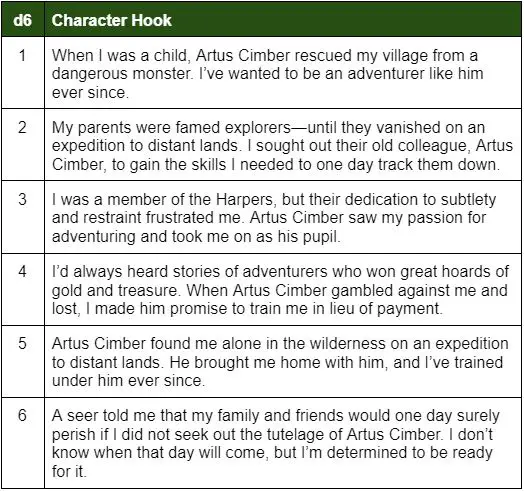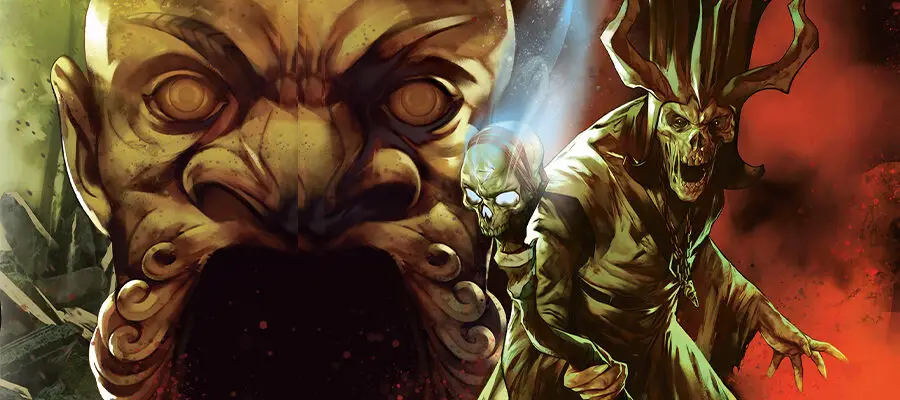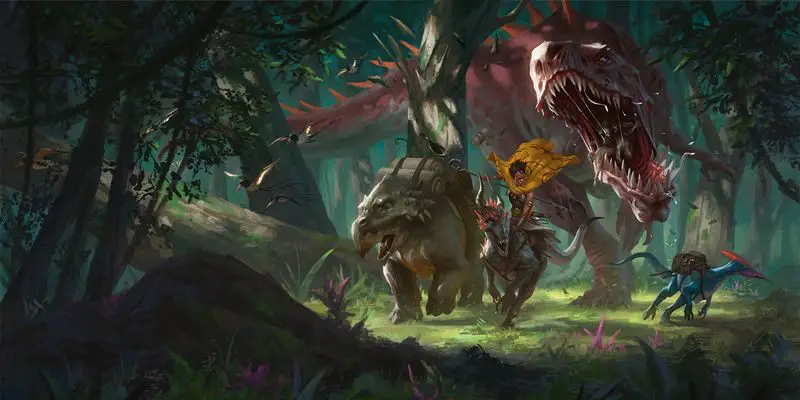Tomb of Annihilation character hooks featured image is from Wizards of the Coast’s Tomb of Annihilation. This article contains affiliate links to put gold in our coffers.
Tomb of Annihilation is one of Dungeons & Dragons 5th Edition’s most popular campaign modules—and for good reason! As an exploration-focused, hex-crawling adventure, Tomb fills a niche that few other 5e modules do—especially considering its reputation as 5th Edition’s most challenging “meatgrinder” campaign.
Yet Tomb of Annihilation, like its sister module Descent Into Avernus, suffers from a critical problem: Why on earth has its central quest (here, the mission to lift Acererak’s death curse) been assigned to a party of low-level, amateur player characters—and why does the central questline functionally disappear from the plot for the bulk of the campaign?
The player characters of Tomb of Annihilation deserve a better adventuring hook—and stronger, more vibrant character hooks as well. Let’s take a closer look at exactly what problems it’s facing, and what we can do to solve them.
A Depressing Hook to Bite
Tomb, ultimately, faces a fundamental two-pronged dilemma. Most D&D players, understandably, want to be Big Epic Heroes who go on a quest to Save The World. Yet most D&D players also want to start as first-level “local heroes,” like Frodo or Luke Skywalker.
Tomb of Annihilation’s adventure hook represents an attempt for Wizards of the Coast to both have its cake and eat it too: the PCs are assigned a Big Epic Quest from Page One of the adventure, but they’re also given the opportunity to learn and grow as they pursue it.
This, however, feels exceptionally clumsy. Are there really no other adventurers who’ve managed to escape the death curse? Does anyone actually expect a party of 1st-level PCs to make their way across Chult—the Forgotten Realms’ “unexplored continent”—and actually lift a curse that famous mages and priests couldn’t?
According to the adventure hook, Syndra Silvane—the module’s initial quest-giver—doesn’t seem to have much faith in their chances. But savvy players are sure to catch on to her aura of resignation, or to question their role in this high-level quest. The conclusion that their assignment is a desperate, last-ditch effort—a functional suicide mission—seems inescapable.
Some groups might enjoy that kind of challenge. But for others, it might feel that their success is preordained—a gift of the DM’s generosity. The PCs won’t lift the death curse because they’re skilled. Instead, the PCs will only succeed because they’re lucky—because, compared to the “other, more experienced parties of adventures [that] have been sent to Chult already,” they’re the main characters.
There’s also a total absence of personal stakes here. It’s very sad that Syndra Silvane is dying, yes. But most players will have no idea who she is. Tomb’s adventure hook fundamentally relies on the players’ investment in Faerun, expecting news of the death curse to shock and anger players who’ve fallen in love with its worldbuilding. But for a group of players with little-to-no investment in the Sword Coast, Icewind Dale, or any other Forgotten Realms setting, the death curse is just an excuse to Go On An Adventure.
In contrast to Wild Beyond the Witchlight’s “Lost Things” adventure hook or even Curse of Strahd’s “Creeping Fog,” “Syndra Silvane’s Curse” just fundamentally falls flat. If Tomb wants its central storyline to be more like Lord of the Rings or Star Wars, it’s going to have to adapt its hook to fit.
Creating Strong Character Hooks
The beginning of Star Wars: A New Hope can teach us something incredibly valuable about epic storytelling: a narrative is more meaningful when it’s personal.
In A New Hope, Luke Skywalker begins as an ordinary moisture farmer on Tatooine. But that all changes when the Empire murders his aunt and uncle—his adoptive parents—and inadvertently sets him on a journey of self-discovery that will see him join the Rebellion, become a Jedi, and overthrow the Emperor himself.
Imagine if Ben Kenobi had instead approached Luke, said, “The Empire just killed two random people in the next town over,” and asked him to help kill the Emperor. That wouldn’t have worked nearly as well—but that’s functionally what Tomb of Annihilation is asking us to do. In doing so, Tomb fails to leverage the power of robust character backgrounds—but with a few minor changes, we can fix that.
We need two things to fix Tomb’s current hook: a personal connection, and a slow “on-ramp” (i.e., a humble beginning to match the PCs’ humble origins). Fortunately, Tomb of Annihilation provides all of the ingredients we need to make that happen, starting with the adventure’s most enigmatic NPC: the adventurer and former Harper agent, Artus Cimber—the keeper of the legendary ring of winter.
To make this adventure personal, we’re going to do two things. First, we’re going to make Cimber into the PCs’ personal adventuring “mentor”; for one reason or another, he’s decided to take these novice, wannabe adventurers under his wing, and has been training and educating them in the ways of heroism. (Think Philoctetes in Disney’s Hercules.)
We can further strengthen this adventure hook by giving our players personal character hooks to draw them in. As your players progress through the character creation process, consider giving them any of the following character hooks:

We begin our campaign at Level 1, just outside of a short dungeon. This can be any dungeon you like—even Matt Colville’s famous Delian Tomb. (Just make sure it’s easy enough for a party of 1st-level PCs to beat without too much trouble—a Draining adventuring day according to this guide would be suitable.)
This is the PCs’ “graduation quest”—if they can complete it successfully, Cimber will recognize them as worthy adventurers and end their training. Cimber has accompanied them this far, but will proceed no further, preferring to watch and wait on the sidelines unless he’s needed.
When the quest concludes, Cimber congratulates the PCs, personally remarking upon their individual achievements. Upon returning home, the group celebrates with plentiful drinks and food. As the night draws to a close, Cimber also solemnly presents them with gifts, giving each character an uncommon wondrous item that fits their abilities and personality. (For example, a rogue might receive the boots of elvenkind, while a cleric might receive a driftglobe.) Cimber then dismisses the PCs and invites them to return to his home in the morning, promising a choice of proper adventuring quests for them to undertake.
Upon arriving at Cimber’s home the following morning, however, the PCs discover that their mentor’s home has been ransacked—clearly the subject of a brawl. Puddles of blood litter the floorboards, and multiple piles of furniture have been smashed.
And Artus Cimber himself is nowhere to be found.
Tales of the Forbidden City
As the characters investigate, they can easily find that one particular blood trail leads upward to the second floor. The trail ends at the corpse of a yuan-ti pureblood, which has been dragged to rest on the second-floor landing. The corpse’s hands have been moved, with its left hand pointing toward the floor of the smashed-up room below and its right hand pointing toward the entrance to Cimber’s second-floor study. A character who peers over the railing can see that the blood-smears and smashed debris below have been arranged to create the word “OMU”—a hidden message from Cimber.
If the characters search the voluminous bookshelves of Cimber’s study after reading the hidden message, they automatically find a slim volume titled Omu: The Forbidden City of Chult. The book contains the information provided in the “Forbidden City” subsection on page 92 of the adventure. It’s up to the characters to find safe passage to Chult, secure supplies and a guide in Port Nyanzarou, and begin the long trek across the unexplored continent in search of the lost city of Omu—and their missing mentor.
Upon their arrival in Chult, the characters can also see the results of the death curse firsthand. During the voyage, their ship’s captain loudly boasts of winning the love of a priestess of Umberlee, who raised him from the dead after a kraken attacked his former crew. Immediately upon setting foot in Port Nyanzarou, however, the captain falls ill with a mysterious wasting sickness.
As they explore Port Nyanzarou, the characters can learn that the sickness has struck multiple members of Port Nyanzarou over the past several days, including Mother Sibonseni, the Chief Priest of Waukeen here (see subsection “21. Hall of Gold” on p. 23). They can also learn that recent efforts to resurrect the spouse of Jessamine, one of Port Nyanzarou’s merchant princes, have failed (Jessamine herself has not been seen in public for days)—and that most suspect the two events to be related.
Local magi and clerics agree that this is no ordinary illness, but a curse—an affliction upon magic itself. Rumor has it that the sickness affects every person who was formerly raised from the dead, and that it began at an isolated outpost in the depths of the jungle more than a fortnight ago—which means that it’s spreading.
As the characters explore Chult, they’ll meet some NPCs who have previously encountered Cimber on a previous expedition to the continent long ago. They’ll even meet NPCs who can share eyewitness accounts of a platoon of yuan-ti escorting a human male matching his description through the jungle—though to where, no one is sure.
Some NPCs even claim that they’ve seen Cimber even more recently, suggesting that he managed to escape his captors for a time—until he was inevitably recaptured by a powerful mage and spirited away to an unknown location.
Where he is now, though, no one knows.
Where’s Artus Cimber?
After fighting off an assault force of yuan-ti at his home, Cimber was ultimately overcome by the attacker’s reinforcements, and was spirited away to Omu. There, he was held as a prisoner in the Oubliette of the Tomb of the Nine Gods (see section 57, “Oubliette,” on p. 168) until fairly recently.
Acererak sought to kidnap him in order to seize the ring of winter from his person—a powerful artifact that contained a spark of Auril’s divinity within it. Acererak plans to extract the divine spark in order to allow for the atropal’s apotheosis once it has consumed enough souls.
While even Acererak found the ring of winter difficult to remove from Cimber’s person, he was eventually successful and gave Cimber to the yuan-ti of Omu as a gift for their loyalty. Cimber is now a prisoner of Ras Nsi in the Fane of the Night Serpent (see section 8, “Prisoner Pits” on p. 118) waiting to be sacrificed to Dendrar, the Night Serpent.
It’s here that the characters can find and rescue him—though, without the ring’s life-sustaining magic, Cimber has rapidly begun to age, preventing him from accompanying the characters into the Tomb of the Nine Goods. What he can do, however, is share that the lich Acererak is responsible for his disappearance—and with the spark of divinity he’s extracted from the ring of winter, the world itself is surely at risk.
Can the characters delve into the lich’s treacherous dungeon, defeat his nefarious death curse, and save their mentor’s life by reclaiming and restoring the ring of winter?
There’s only one way to find out.
About the Author: DragnaCarta is a guest writer for FlutesLoot.com and a veteran DM with 12+ years of experience. He is the author of the popular “Curse of Strahd: Reloaded” campaign guide and the Dungeon Master and director for the Curse of Strahd livestream “Twice Bitten.” You can get his personal RPG mentoring plus early access to projects by joining his Patreon.
Cast Message in the comments section below to ask DragnaCarta about this topic. You can find other articles by DragnaCarta on FlutesLoot.com.





I ran this campaign as a new DM at the start of the pandemy, and a hook like this is a much better hook than how it begins. I ran the Cellar of Death off dmsguild as a more involved hook, where the players collectively create a beloved NPC they attend the funeral of. I think that works fine, but given all my players were new, that person was effectively forgotten — they didn’t even remember her name after a few sessions. And having more experience under my belt at this point, there’s more that could have been done. Hindsight and all that.
Your hook I think does something that was sorely needed with the cameo that is Artus Cimber, and that was make him feel like more than a potential deus ex machina to save the PCs in the jungle at random times. That he, and Ras Nsi for that matter, are legacy characters from old FR novels that get very little explanation of their history in the book is a shame.
I’m a player in the campaign right now, and we recently ran into Artus when we visited an oracle. He gave off the vibe that he’s important to the campaign, so he’s tagging along with us, but I have no idea what his deal is. Maybe I should talk to him more.